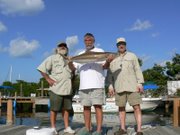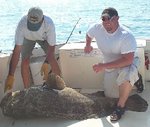I have been getting a lot more Yellowtail catching calls. Some turn into trips which I like but a lot just turn into fishing for information. I don't mind that, but I also like to make a little cash every now and then. So I have posted a lot of information on the blog about fishing basics and added a paypal button so you can make a little donation to the poor captain's fund (me) if you find it helpful.
The biggest thing I seem to do is teach people how to operate their electronics. Setting your gain on your sonar is a huge part of the job. If you set your gain too high, you think fish are everywhere. Too low and you never seem to find fish. Since every boat is set up different I have gotten into a bit of an old school habit of looking for structure, changes in the bottom more than looking for "fish" which can be real fish, bait, noise or something splattered on the bottom finder screen.
Knowing something about the area you are fishing and the types of fish you are likely to find is a huge help. This is local knowledge which helps me "calibrate" your bottom finder. Fishing out of Marathon mostly, I have a dozen or so "public" numbers I share more to learn about what is going on than actually limiting out on fish. Catching Grouper and big Mangroves on these "public" spots is pretty hard because they get hit hard. Yellowtail though tend to be trainable along with smaller Mangroves and various bait fish so you still get plenty of action most of the time. The object though is to show you what you are looking for structure wise.
Flag Yellowtail are very popular but also not exactly easy to hammer for a new comer. "Generally", they are in deeper water, 70 to 100 foot and like a coral head, wreck or ledge for their home base. When they are active, it is hard to mistake the mark they make on your sonar. However, they tend to like a particular current to get active and how much current and what direction depends on their mood and the area.
I did a trip on the Harvest Moon a few days ago and the bite was very slow and the fish didn't mark up like they were active. I knew that ahead of time and had told the crew that it would be slow and that when we got a bite going, it would not last as long as "normal". We never got the 'tails fired up but caught enough for dinner plus a bragging size Mangrove, keeper Red Grouper and a nice Porgie and missed a few larger fish that caught the guys off guard. It was a slow day but productive, so if you have to fish the full moon, just be aware that the bite will be a little more funky than normal and put some other baits out for quality fish that aren't Yellowtail. It is all good.
Off Marathon, the flags generally like a moderate current flowing toward deeper water. However, if they are holding on a head or wreck, just having a current is enough provide you anchor up current of that head so your chum is working the right spot.
This would be a legitimate Flag Yellowtail. We didn't weigh it but it was in the 6 pound range and over 25" long. We lost several larger fish, which happens to be best of anglers but a lot more often when you are learning to catch Flag Yellowtail. If you lose one or two of the really big girls, you bite can run off with the lost fish. So if you hook one, you want to get it to the boat if you plan on catching a mess.
To do that you want to have a larger hook, heavier leader and a tighter drag setting. However, you cannot go too large, too heavy or too tight, so you need a reasonable starting point. That is a 2/0 hook, 20 pound leader and about 10 pounds of drag. If the water is crystal clear and the current light, this probably won't work so you have to adjust lighter until you find your combination for that spot on that day.
I also recommend leaving the braided line on the dock if you are serious about Yellowtail. Old fashion clear monofiliment is the best all around line with a fairly long fluorocarbon leader if the water is clear. Some people are dedicated to coffee colored or bronze hooks, certain model feathers or jigs, the perfect bait and double top secret chum recipes, but technique tends to be the real secret. That means finding the right combination of weight, leader, bait size, bait type and drift rate. I could make it super complicated, but just starting off with the normal combination and adjusting to conditions is a lot easier to remember.
Spinning tackle also makes life simpler. You can use a "trout" rod (bait caster), but if you get a hard hit you are likely to get a backlash and you have to spend more time stripping line. If you want to use your "ultralight" with braid, you can use that also, but you need a very long leader most of the time and if the fish rocks you up, that just mean lots more leader trashing up the reef. Using clean mono with a shorter leader or no leader at all, not only makes life simpler it also is more reef friendly. So having a dedicated Yellowtail outfit, spinning combo with a nice comfortable rod loaded with clear mono or fluorocarbon in the 15# to 20# range makes you look like a trained professional.
This time of year I get more last minute calls because of weather and I get a surprisingly large number of calls from locals looking to fine tune their methods and find a few closer to home spots so they can get in some after or before work fishing. So if you are interested, call me (305) 304-8656 or you can check some of the fishing basic posts and if you find something helpful, think about that captain's tip jar.
Marathon in the Florida Keys should be your next fishing vacation destination. Join us for charter fishing, fishing guide trips or our fishing 101 so you can fish on your own with better success.
Tight lines,
Capt. Dallas





No comments:
Post a Comment